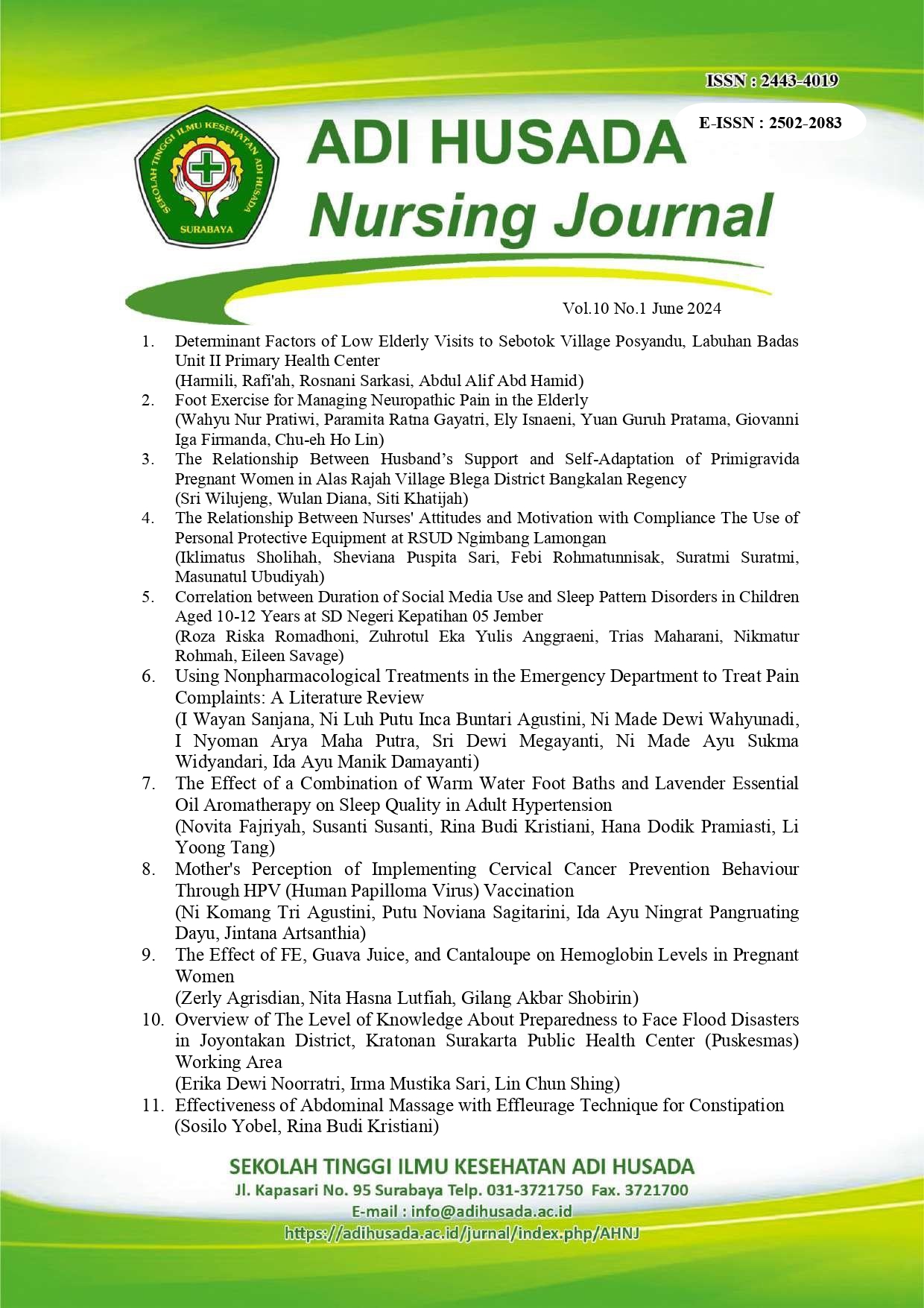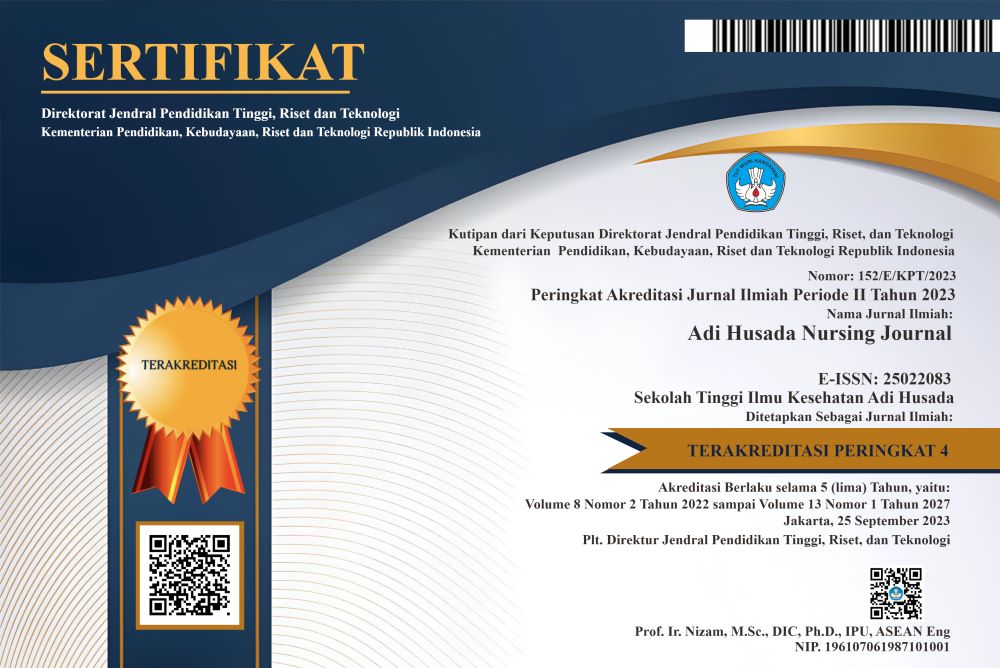Correlation between Duration of Social Media Use and Sleep Pattern Disorders In Children Aged 10-12 Years at SD Negeri Kepatihan 05 Jember
Abstract
Social media usage can both positively and negatively affect children's sleep patterns, with potential negative effects on the quality and quantity of sleep. However, until now, more evidence is needed about the phenomenon in a population of school-age children. This study aims to analyze the relationship between the duration of social media use and sleep pattern disturbances in children aged 10-12 years at SD Negeri Kepatihan 05 based on the theory of problematic smartphone use. The research design uses a correlational approach with a cross-sectional approach. The population of children aged 10-12 years at SD Negeri Kepatihan 05 Jember is 250 respondents. The number of samples was 104 using simple random sampling. Data collection on the duration of social media use used an observation sheet while sleep pattern disturbances used a questionnaire sheet. Data analysis used rho sperm with the condition α ≤ 0.05. The results showed that there was a relationship between the duration of social media use and disturbed sleep patterns in children aged 10-12 years. The correlation in this study shows an r-value of 0.230 which identifies the degree of weak relationship, p-value of 0.019. The duration of social media use has been found to have a positive relationship with disturbed sleep patterns. This study concluded that prolonged social media use can disrupt sleep patterns in children, emphasizing the need for parental monitoring in this context.
References
Busch, P. A., & McCarthy, S. (2021). Antecedents and consequences of problematic smartphone use: A systematic literature review of an emerging research area. Computers in Human Behavior, 114(May 2020), 106414. https://doi.org/10.1016/j.chb.2020.106414
Dameyanti Manurung, N. (2020). Durasi Penggunaan Media Sosial Dan Insomnia Pada Remaja : Studi Literatur Sebagai. Recruit Researchers, 344(November), 0–7.
Eritriana, R. E., & . P. (2022). Hubungan Penggunaan Gadget dengan Pola Tidur Anak Usia Sekolah (10-12 tahun) di SDN Bintoyo Kecamatan Padas Kabupaten Ngawi. E-Journal Cakra Medika, 9(2), 44. https://doi.org/10.55313/ojs.v9i2.117
Fatimah Diantoro, M. H., Anantyo, D. T., & Rahmadi, F. A. (2021). Hubungan Durasi Paparan Media Elektronik Terhadap Pola Tidur Anak Usia 10-13 Tahun. Sari Pediatri, 22(6), 359. https://doi.org/10.14238/sp22.6.2021.359-63
Fatriansari, A., & Afriyani, R. (2021). Penggunaan Media Sosial Dengan Kejadian Insomnia Pada Mahasiswa STIK Siti Khadijah Palembang. Jurnal Keperawatan Sriwijaya, 8(2), 12–18. https://doi.org/10.32539/JKS.V8i2.15298
Hepilita, Y., & Gantas, A. A. (2018). Hubungan Durasi Penggunaan Media Sosial dengan Gangguan Pola Tidur pada Anak Usia 12 sampai 14 Tahun di SMP Negeri 1 Langke Rembong. Jurnal Wawasan Kesehatan, 3(2), 78–87.
Indriani, N. (2022). Pola Tidur Anak Usia 10-12 Tahun dengan Riwayat Penggunaan Smartphone. Profesional Health Journal, 4(1), 148–154. https://doi.org/10.54832/phj.v4i1.339
Isnaningsih, T., & Sari, F. W. (2022). Hubungan Perilaku dan Frekuensi Penggunaan Gadget dengan Kualitas Tidur pada Remaja. Formosa Journal of Science and Technology, 1(4), 205–216. https://doi.org/10.55927/fjst.v1i4.877
Masril, M., & Lubis, F. W. (2020). Analisis Penggunaan Media Sosial dan Penyebaran Hoax Di Kota Medan. Jurnal Simbolika: Research and Learning in Communication Study, 6(1), 11–22. https://doi.org/10.31289/simbollika.v6i1.2937
Nila, H., & Herlia, S. N. (2020). The Relationship Between the Habit of Playing Online Games in School-Age Children with. Kesehatan Global, 3(3), 116–122.
Purboningsih, E. R., Massar, K., Hinduan, Z. R., Agustiani, H., Ruiter, R. A. C., & Verduyn, P. (2023). Perception and use of social media by Indonesian adolescents and parents: A qualitative study. Frontiers in Psychology, 13, 1–18. https://doi.org/10.3389/fpsyg.2022.985112
Putri Gavinta D A, F. K. (2021). Keterlibatan Orang Tua Terhadap Intervensi Anak Usia Dini Yang Mengalami Kesulitan Tidur(Insomnia). Tumbuh Kembang: Kajian Teori Dan Pembelajaran PAUD, 8(1), 1–11. https://doi.org/10.36706/jtk.v8i1.13715
Qomariah, S. N., Amin, N. S., Azizah, Y. N., & Huda, M. (2023). Stress Management Education and Training Program Reduces The Anxiety Levels Of Students Facing The National High School Exam. Synthesis Global Health Journal, 1-9.
Radityo, W. E. (2020). Depresi dan Gangguan Tidur. Medika Udayana, 1(1), 1–16.
Rodli, A. F., & Wulandari, F. (2022). Daampak Media Sosial Terhadap Perubahan Siswa Sekolah Dasar. Jurnal Pendidikan Dasar Indonesia, 7(2), 46–52.
Rukmini, R., Qomariah, S. N., & Savage, E. (2024). Assessing patient safety implementation and its associate factors in a pediatric inpatient ward. Universa Medicina, 43(1), 4-12.
SDKI. (2019). Standar Diagnosis Keperawatan Indonesia. DPP PPNI.
Tanjung, M. C., & Sekartini, R. (2016). Masalah Tidur pada Anak. Sari Pediatri, 6(3), 138. https://doi.org/10.14238/sp6.3.2004.138-42
Suyanto, S., Qomariah, S. N., Syaiful, Y., & Fatmawati, L. (2023). LEGAL CASE AND HEALTH PERSPECTIVE OF BULLYING LEADING TO BLINDNESS. EQUALEGUM International Law Journal, 143-147.
Wahyuningrum, E. (2021). Review: Gangguan Tidur Anak Usia Sekolah. Jurnal Keperawatan, 13(3), 699–708.
Witantri, A. A. A., Putri, S., Lestari Mp, P., Ketut, I., & Widarsa, T. (2022). Hubungan Lama Penggunaan Gadget dengan Gangguan Pola Tidur pada Anak Sekolah Dasar Kelas 4 Sampai 6 di Denpasar. Aesculapius Medical Journal |, 2(2), 1–6.
Yuniati, U., & Puspitasari, E. E. (2019). Motif Pendengaran Radio Di Era Perkembangan Teknologi Informasi (Studi Kepuasan Penggunaan Media Pada Generasi Z DI Bandung). J-IKA, 6(2), 83–90. https://doi.org/10.31294/kom.v6i2.6504
Keywords
Children, Sleep Pattern Disorders, Social Media Use

This work is licensed under a Creative Commons Attribution 4.0 International License.








